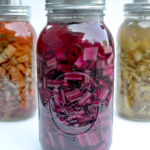Description
Lacto-fermentation is a wonderful way to naturally preserve produce. The process makes use of Lactobacillus bacteria, which naturally exists on the surface of vegetables and is able to convert sugars into lactic acid. Lactic acid, along with being a natural preservative, is what gives fermented foods their wonderfully sour, tangy flavor. The health benefits of the chard stems are amplified by the fermentation process, making the existing minerals easier for the body to digest.
Ingredients
- 5 cups water
- 3 Tbsp plus 2 1/4 tsp sea salt
- 7 cups roughly chopped chard stems
Instructions
- In a small pot, boil water, then combine with sea salt in a medium bowl. Stir periodically until salt is dissolved. Set aside until brine has cooled to room temperature.
- Add chard stems to a wide-mouth half-gallon jar, filling to the shoulder of the jar.
- Pour enough brine into the jar to cover the vegetables by 1 inch.
- Place Kraut Source or similar airlock device (see note) onto the jar. Place in a cool area away from direct sunlight and allow to sit for 7 to 14 days.
- Check daily to make sure the moat of the airlock is filled, and top off with water if needed.
- Periodically taste your ferment. Once you have reached your desired level of sourness, remove the Kraut Source, replace with a wide-mouth mason jar lid, and store in the refrigerator, where the ferment will last for several months.
Notes
The Kraut Source used in this recipe is available at www.krautsource.com. There are other similar airlock devices available on the market that can be used to seal the fermenting jar so that oxygen is kept out while allowing carbon dioxide to escape.
